Introduction: World of microcontrollers
The situation we find ourselves today in the field of microcontrollers had its beginnings in the development of technology of integrated circuits. This development has enabled us to store hundreds of thousands of transistors into one chip. That was a precondition for the manufacture of microprocessors. The first computers were made by adding external peripherals such as memory, input/output lines, timers and others to it. Further increasing of package density resulted in creating an integrated circuit which contained both processor and peripherals. That is how the first chip containing a microcomputer later known as a microcontroller has developed.
This is how it all got started...
In the year 1969, a team of Japanese engineers from BUSICOM came to the USA with a request that a few integrated circuits for calculators were to be designed according to their projects. The request was sent to INTEL and Marcian Hoff was in charge of the project there. Having experience working with a computer, the PDP8, he came up with an idea to suggest fundamentally different solutions instead of the suggested design. This solution presumed that the operation of integrated circuit was to be determined by the program stored in the circuit itself. It meant that configuration would be simpler, but it would require far more memory than the project proposed by Japanese engineers. After a while, even though the Japanese engineers were trying to find an easier solution, Marcian’s idea won and the first microprocessor was born. A major help with turning an idea into a ready-to-use product was Federico Faggin. Nine months after hiring him, Intel succeeded in developing such a product from its original concept. In 1971 Intel obtained the right to sell this integrated circuit. Before that Intel bought the license from BUSICOM which had no idea what a treasure it had. During that year, a microprocessor called the 4004 appeared on the market. That was the first 4-bit microprocessor with the speed of 6000 operations per second. Not long after that, an American company CTC requested from Intel and Texas Instruments to manufacture an 8-bit microprocessor to be applied in terminals. Even though CTC gave up this project, Intel and Texas Instruments kept working on the microprocessor and in April 1972 the first 8-bit microprocessor called the 8008 appeared on the market. It was able to address 16Kb of memory, had 45 instructions and the speed of 300 000 operations per second. That microprocessor was the predecessor of all today’s microprocessors. Intel kept on developing it and in April 1974 it launched an 8-bit processor called the 8080. It was able to address 64Kb of memory, had 75 instructions and initial price was $360.
Another American company called Motorola, quickly realized what was going on, so they launched 8-bit microprocessor 6800. Their chief constructor was Chuck Peddle. Apart from the processor itself, Motorola was the first company that also manufactured other peripherals such as the 6820 and 6850. At that time many companies recognized the greater importance of microprocessors and began their own development. Chuck Peddle left Motorola to join MOS Technology and kept working intensively on developing microprocessors.
At the WESCON exhibition in the USA in 1975, a crucial event in the history of the microprocessors took place. MOS Technology announced that it was selling processors 6501 and 6502 at $25 each, that interested customers could purchase immediately. It was such a sensation that many thought it was a kind of fraud, considering that competing companies were selling the 8080 and 6800 at $179 each. On the first day of the exhibit, in response to the competitor, both Motorola and Intel cut the prices of their microprocessors to $69.95. Motorola accused MOS Technology and Chuck Peddle of plagiarizing the protected 6800. Because of that, MOS Technology gave up further manufacture of the 6501, but kept manufacturing the 6502. It was the 8-bit microprocessor with 56 instructions and ability to directly address 64Kb of memory. Due to low price, 6502 became very popular so it was installed into computers such as KIM-1, Apple I, Apple II, Atari, Commodore, Acorn, Oric, Galeb, Orao, Ultra and many others. Soon several companies began manufacturing the 6502 (Rockwell, Sznertek, GTE, NCR, Ricoh, Commodore took over MOS Technology). In the year of its prosperity 1982, this processor was being sold at a rate of 15 million processors per year!
Other companies did not want to give up either. Frederico Faggin left Intel and started his own company Zilog Inc. In 1976 Zilog announced the Z80. When designing this microprocessor Faggin made a crucial decision. The 8080 had already been developed and he realized that many would remain loyal to that processor because of the great expenditures which rewriting of all the programs would result in. Accordingly he decided that a new processor had to be compatible with the 8080, i.e. it had to be able to perform all the programs written for the 8080. Apart from that, many other features have been added so that the Z80 was the most powerful microprocessor at that time. It was able to directly address 64Kb of memory, had 176 instructions, a large number of registers, a built-in option for refreshing dynamic RAM memory, a single power supply, greater operating speed etc. The Z80 was a great success and everybody replaced the 8080 by the Z80. Certainly the Z80 was commercially the most successful 8-bit microprocessor at that time. Besides Zilog, other new manufacturers such as Mostek, NEC, SHARP and SGS appeared soon. The Z80 was the heart of many computers such as: Spectrum, Partner, TRS703, Z-3 and Galaxy.
In 1976 Intel came up with an upgraded version of the 8-bit microprocessor called the 8085. However, the Z80 was so much better that Intel lost the battle. Even though a few more microprocessors appeared later on the market (6809, 2650, SC/MP etc.), the die had already been cast. There were no such great improvements which could make manufacturers to change their mind, so the 6502 and Z80 along with the 6800 remained chief representatives of the 8-bit microprocessors of that time.
Microcontroller versus Microprocessor
A microcontroller differs from a microprocessor in many ways. The first and most important difference is its functionality. In order that the microprocessor may be used, other components such as memory must be added to it. Even though the microprocessors are considered to be powerful computing machines, their weak point is that they are not adjusted to communicating to peripheral equipment.
Simply, In order to communicate with peripheral environment, the microprocessor must use specialized circuits added as external chips. In short microprocessors are the pure heart of the computers. This is how it was in the beginning and remains the same today.
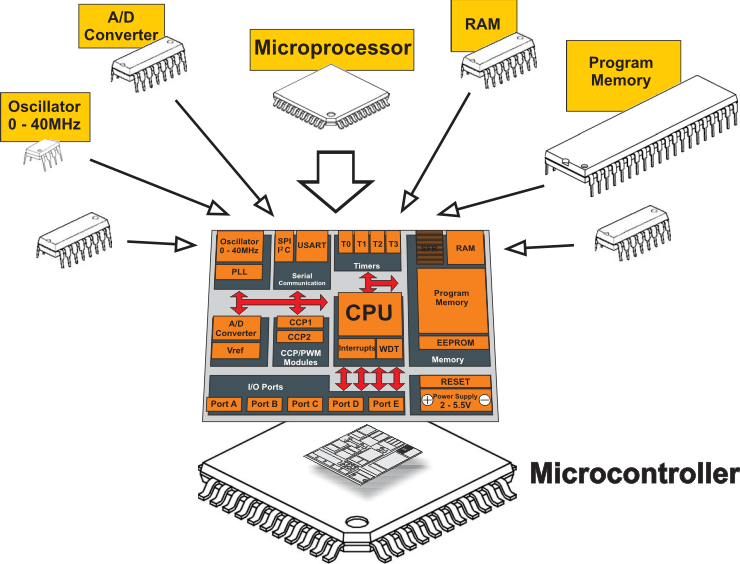
Fig. 0-1 Microcontroller versus Microprocessor
On the other hand, the microcontroller is designed to be all of that in one. No other specialized external components are needed for its application because all necessary circuits which otherwise belong to peripherals are already built into it. It saves the time and space needed to design a device.
BASIC CONCEPT
Did you know that all people can be classified into one of 10 groups- those who are familiar with binary number system and those who are not familiar with it. You don’t understand? That means that you still belong to the later group. If you want to change your status read the following text describing briefly some of the basic concepts used further in this book (just to be sure we are on the same page).
World of Numbers
Mathematics is such a good science! Everything is so logical and simple as that. The whole universe can be described with ten digits only. But, does it really have to be like that? Do we need exactly ten digits? Of course not, it is only a matter of habit. Remember the lessons from the school. For example, what does the number 764 mean: four units, six tens and seven hundreds. Simple! Could it be described in a bit more complicated way? Of course it could: 4 + 60 + 700. Even more complicated? Naturally: 4*1 + 6*10 + 7*100. Could this number look a bit more scientific? The answer is yes: 4*10^0 + 6*10^1 + 7*10^2. What does it actually mean? Why do we use exactly these numbers: 100, 101 and 102 ? Why is it always about the number 10? That is because we use ten different digits (0, 1, 2, ... 8, 9). In other words, because we use base-10 number system, i.e. decimal number system.
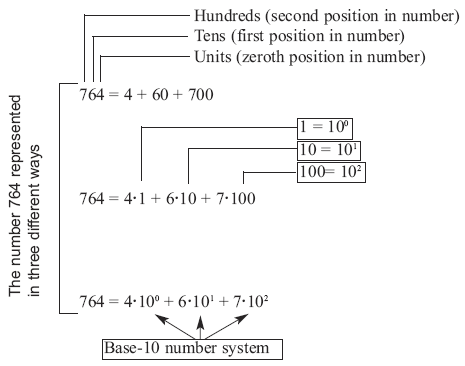
Fig. 0-2 The number 764 represented in three different ways
Binary Number System
What would happen if only two digits would be used- 0 and 1? Or if we would not know to determine whether something is 3 or 5 times greater than something else? Or if we would be restricted when comparing two sizes, i.e. if we could only state that something exists (1) or does not exist (0)? Nothing special would happen, we would keep on using numbers in the same way, but they would look a bit different. For example: 11011010. How many pages of a book does the number 11011010 include? In order to learn that, follow the same logic like in the previous example, but in reverse order. Bear in mind that all this is about mathematics with only two digits- 0 and 1, i.e. base-2 number system (binary number system).
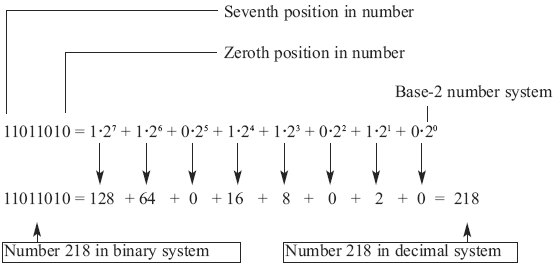
Fig. 0-3 The number 218 represented in binary and decimal system
Clearly, it is the same number represented in two different ways. The only difference is in the number of digits necessary for writing some number. One digit (2) is used to write the number 2 in decimal system, whereas two digits (1 and 0) are used to write that number in binary system. Do you now agree that there are 10 groups of people? Welcome to the world of binary arithmetic! Do you have any idea where it is used?
Excepting strictly controlled laboratory conditions, the most complicated electronic circuits cannot accurately determine the difference between two sizes (two voltage values, for example) if they are too small (lower than several volts). The reasons are electrical noises and something called the “real working environment” (unpredictable changes of power supply voltage, temperature changes, tolerance to values of built in components etc.). Imagine a computer which would operate upon decimal numbers by recognizing 10 digits in the following way: 0=0V, 1=5V, 2=10V, 3=15V, 4=20V... 9=45V !? Did anybody say batteries? A far simpler solution is the use of binary logic where 0 indicates that there is no voltage and 1 indicates that there is voltage. It is easier to write 0 or 1 instead of “there is no voltage” or “there is voltage”. It is called logic zero (0) and logic one (1) which electronics perfectly conforms with and easily performs all those endlessly complex mathematical operations. It is electronics which in reality applies mathematics in which all numbers are represented by two digits only and in which it is only important to know whether there is voltage or not. Of course, we are talking about digital electronics.
Hexadecimal Number System
At the very beginning of computer development it was realized that people had many difficulties in handling binary numbers. Because of this, a new numbering system had to be established. This time, a number system using 16 different digits. The first ten digits are the same as digits we are used to (0, 1, 2, 3,... 9) but there are six digits more. In order to keep from making up new symbols, the six letters of alphabet A, B, C, D, E and F are used. A hexadecimal number system consisting of digits: 0, 1, 2, 3, 4, 5, 6, 7, 8, 9, A, B, C, D, E, F has been established. What is the purpose of this seemingly bizarre combination? Just look how perfectly everything fits the story about binary numbers.

Fig. 0-4 Binary and Hexadecimal number
The largest number that can be represented by 4 binary digits is the number 1111. It corresponds to the number 15 in decimal system. That number is in hexadecimal system represented by only one digit F. It is the largest onedigit number in hexadecimal system. Do you see how skillfully it is used? The largest number written with eightdigits is at the same time the largest twodigit hexadecimal number. Bear in mind that the computer uses 8-digit binary numbers.
BCD Code
BCD code is actually a binary code for decimal numbers only. It is used to enable electronic circuits to communicate in a decimal number system with peripherals and in a binary system within “their own world”. It consists of fourdigit binary numbers which represent the first ten digits (0, 1, 2, 3 ... 8, 9). Even though four digits can give a total of 16 possible combinations, only the first ten are used.
Number System Conversion
The binary numbering system is the most commonly used, the decimal system is the most understandable while the hexadecimal system is somewhere between them. Therefore, it is very important to learn how to convert numbers from one numbering system to another, i.e. how to turn a series of zeros and units into values understandable to us.
Binary to Decimal Number Conversion
Digits in a binary number have different values depending on their position in that number. Additionally, each position can contain either 1 or 0 and its value may be easily determined by its position from the right. To make the conversion of a binary number to decimal it is necessary to multiply values with the corresponding digits (0 or 1) and add all the results. The magic of binary to decimal number conversion works...You doubt? Look at the example:
110 = 1*2^2 + 1*2^1 + 0*2^0 = 6
It should be noted that for decimal numbers from 0 to 3 you only need two binary digits. For greater values, extra binary digits must be added. Thus, for numbers from 0 to 7 you need three digits, for numbers from 0 to 15- four digits etc. Simply speaking, the largest binary number consisting of n digits is obtained when the base 2 is raised by n. The result should be then subtracted by 1. For example, if n=4:
2^4 - 1 = 16 - 1 = 15
Accordingly, using 4 binary digits it is possible to represent decimal numbers from 0 to 15, including these two digits, which amounts to 16 different values in total.
Hexadecimal to Decimal Number Conversion
In order to make conversion of a hexadecimal number to decimal, each hexadecimal digit should be multiplied with the number 16 raised by its position value. For example:

Fig. 0-5 Hexadecimal to decimal number conversion
Hexadecimal to Binary Number Conversion
It is not necessary to perform any calculation in order to convert hexadecimal numbers to binary numbers. Hexadecimal digits are simply replaced by the appropriate four binary digits. Since the maximum hexadecimal digit is equivalent to decimal number 15, we need to use four binary digits to represent one hexadecimal digit. For example:

Fig. 0-6 Hexadecimal to binary number conversion
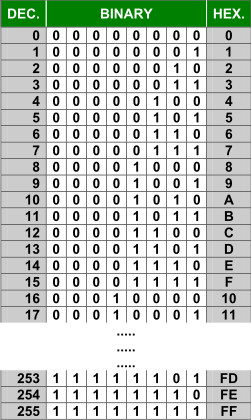
Comparative table below contains the values of numbers 0-255 in three different numbering systems.
Marking Numbers
The hexadecimal numbering system is along with binary and decimal number systems considered to be the most important for us. It is easy to make conversion of any hexadecimal number to binary and it is also easy to remember it. However, these conversions may cause confusion. For example, what does the statement “It is necessary to count up 110 products on assembly line” actually mean? Depending on whether it is about binary, decimal or hexadecimal, the result could be 6, 110 or 272 products, respectively! Accordingly, in order to avoid misunderstanding, different prefixes and suffixes are directly added to the numbers. The prefix $ or 0x as well as the suffix h marks the numbers in hexadecimal system. For example, hexadecimal number 10AF may look as follows $10AF, 0x10AF or 10AFh. Similarly, binary numbers usually get the suffix % or 0b, whereas decimal numbers get the suffix D.
Bit
Theory says a bit is the basic unit of information... Let’s forget this dry explanation for a moment and take a look at what it is in practice. The answer is nothing special a bit is a binary digit. Similar to decimal number system in which digits in a number do not have the same value ( for example digits in the number 444 are the same, but have different values), the “significance” of the bit depends on the position it has in the binary number. Therefore, there is no point talking about units, tens etc. Instead, here it is about the zero bit (rightmost bit), first bit (second from the right) etc. In addition, since the binary system uses two digits only (0 and 1), the value of one bit can be 0 or 1.
Don’t be confused if you find some bit has value 4, 16 or 64. It means that bit’s values are represented in decimal system. Simply, we have got so much accustomed to the usage of decimal numbers that these expressions became common. It would be correct to say for example, “the value of sixth bit in binary number is equivalent to decimal number 64”. But we are human and habits die hard... Besides, how would it sound “number: one-onezero- one-zero...”
Byte
A byte or a program word consists of eight bits grouped together. If a bit is a digit, it is logical that bytes represent numbers. All mathematical operations can be performed upon them, like upon common decimal numbers. As is the case with digits of any other number, byte digits do not have the same significance. The largest value has the leftmost bit called the most significant bit (MSB). The rightmost bit has the least value and is therefore called the least significant bit (LSB). Since eight zeros and units of one byte can be combined in 256 different ways, the largest decimal number which can be represented by one byte is 255 (one combination represents zero).
A nibble is referred to as half a byte. Depending on which half of the byte we are talking about (left or right), there are “high” and “low” nibbles.

Fig. 0-8 High and Low nibbles
Logic Circuits
Have you ever wondered what electronics within some digital integrated circuits, microcontrollers or processors look like? What do the circuits performing complicated mathematical operations and making decisions look like? Do you know that their seemingly complicated schematics comprise only a few different elements called “logic circuits” or “logic gates”?
The operation of these elements is based on the principles established by British mathematician George Boole in the middle of the 19th century- even before the first bulb was invented! In brief, the main idea was to express logical forms through algebraic functions. Such thinking was soon transformed into a practical product which far later evaluated in what today is known as AND, OR and NOT logic circuits. The principle of their operation is known as Boolean algebra. As some program instructions used by the microcontroller perform the same way as logic gates except in the form of commands, the principle of their operation will be discussed here.
AND Gate
A logic gate “AND” has two or more inputs and one output. Let us presume that the gate used in this case has only two inputs. A logic one (1) will appear on its output only in case both inputs (A AND B) are driven to logic one (1).
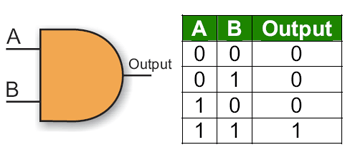
The table shows mutual dependence between inputs and output.
When the gate has more than two inputs, the principle of operation is the same: a logic one (1) will appear on its output only if case all inputs are driven to logic one (1). Any other combination of input voltages will result in a logic zero (0) at its output.
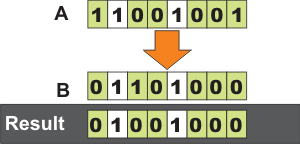
When used in a program, a logic AND operation is performed by the program instruction, which will be discussed later. For the time being, it is enough to remember that logic AND in a program refers to the corresponding bits of two registers.
OR Gate
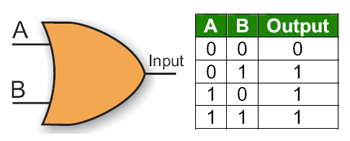
Similarly to the previous case, OR gates also have two or more inputs and one output. A logic one (1) will appear on its output if either input (A OR B) is driven to logic one (1). If all inputs are at logic zero (0), the output will be driven to logic zero (0).
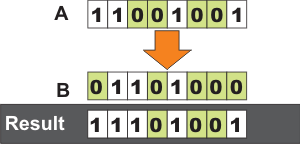
In a program, logic OR operation is performed between the corresponding registers’ bits- the same as in logic AND operation.
NOT Gate

This logic gate has only one input and only one output. It operates in an extremely simple way. When logic zero (0) appears on its input, a logic one (1) appears on its output and vice versa. This means that this gate inverts the signal by itself. It is sometimes called inverter.
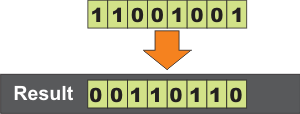
If a program, logic NOT operation is performed on one byte. The result is a byte with inverted bits. If byte is considered to be a number, the inverted value is actually a complement of that number, i.e. the complement of a number is what is needed to add to it to make it reach the maximal 8 bit value (255).
EXCLUSIVE OR Gate
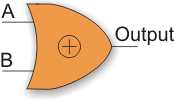
The EXCLUSIVE OR (XOR) gate is a bit complicated comparing to other gates. It represents a combination of all the previously described gates. A logic one (1) appears on its output only when the inputs have different logic states.
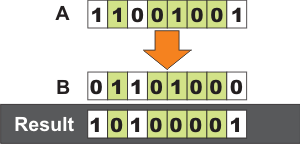
In a program, this operation is commonly used to compare two bytes. Subtraction may be used for the same purpose (if the result is 0, bytes are equal). The advantage of this logic operation is that there is no danger to subtract larger number from smaller one.
Register
A register or a memory cell is an electronic circuit which can memorize the state of one byte.
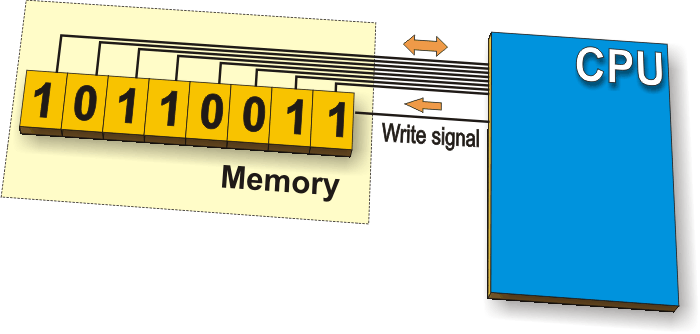
Fig. 0-17 Register
Special Function Register
In addition to the registers which do not have any special and predetermined function, every microcontroller has a number of registers whose function is predetermined by the manufacturer. Their bits are connected (literally) to internal circuits such as timers, A/D converter, oscillators and others, which means that they are directly in command of the operation of the microcontroller. Imagine eight switches which are in command of some smaller circuits within the microcontroller- you are right! Special Function Registers (SFRs) do exactly that!
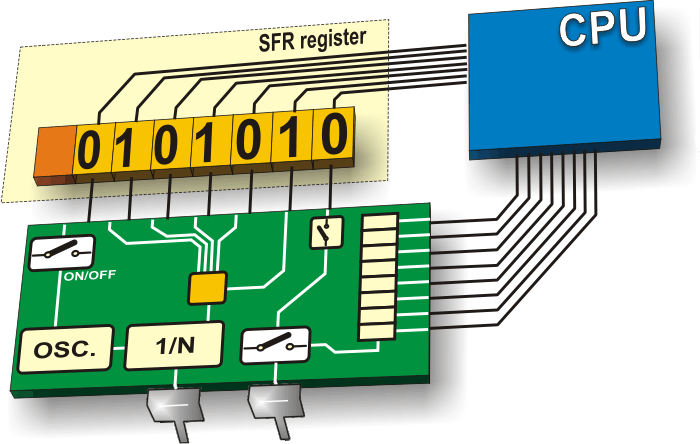
Fig. 0-18 Special Function Register
Input/Output Ports
In order to make the microcontroller useful, it has to be connected to additional electronics, i.e. peripherals. Each microcontroller has one or more registers (called a “port”) connected to the microcontroller pins. Why input/output? Because you can change the pin’s function as you wish. For example, suppose you want your device to turn three signal LEDs and simultaneously monitor the logic state of five sensors or push buttons. Some of ports need to be configured so that there are three outputs (connected to the LEDs) and five inputs (connected to sensors). It is simply performed by software, which means that the pin’s function can be changed during operation.
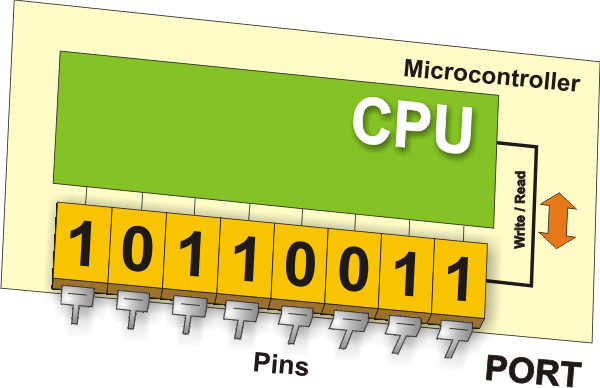
Fig. 0-19 Input / Output ports
One of the more important specifications of input/output (I/O) pins is the maximum current they can handle. For most microcontrollers, current obtained from one pin is sufficient to activate an LED or other similar low-current device (10-20 mA). If the microcontroller has many I/O pins, then the maximum current of one pin is lower. Simply put, you cannot expect all pins to give maximum current if there are more than 80 of them on one microcontroller. Another way of putting it is that the maximum current stated in the data specifications sheet for the microprocessor is shared across all I/O ports.
Another important pin function is that it can have pull-up resistors. These resistors connect pins to the positive power supply voltage and their effect is visible when the pin is configured as an input connected to mechanical switch or push button. Newer versions of microcontrollers have pull-up resistors configurable by software.
Usually, each I/O port is under control of another SFR, which means that each bit of that register determines the state of the corresponding microcontroller pin. For example, by writing logic one (1) to one bit of that control register SFR, the appropriate port pin is automatically configured as input. It means that voltage brought to that pin can be read as logic 0 or 1. Otherwise, by writing zero to the SFR, the appropriate port pin is configured as an output. Its voltage (0V or 5V) corresponds to the state of the appropriate bit of the port register.
Memory Unit
Memory is part of the microcontroller used for data storage. The easiest way to explain it is to compare it with a filing cabinet with many drawers. Suppose, the drawers are clearly marked so that it is easy to access any of them. It is easy enough to find out the contents of the drawer by reading the label on the front of the drawer.
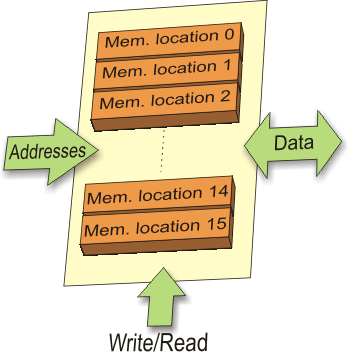
Each memory address corresponds to one memory location. The content of any location becomes known by its addressing. Memory can either be written to or read from. There are several types of memory within the microcontroller.
Read Only Memory (ROM)
ROM (Read Only Memory) is used to permanently save the program being executed. The size of a program that can be written depends on the size of this memory. Today’s microcontrollers commonly use 16-bit addressing, which means that they are able to address up to 64 Kb of memory, i.e. 65535 locations. As a novice, your program will rarely exceed the limit of several hundred instructions. There are several types of ROM.
Masked ROM. Microcontrollers containing this ROM are reserved for the great manufacturers. Program is loaded into the chip by the manufacturer. In case of large scale manufacture, the price is very low. Forget it...
One Time Programmable ROM (OTP ROM). If the microcontroller contains this memory, you can download a program into this memory, but the process of program downloading is a “one-way ticket”, meaning that it can be done only once. If an error is detected after downloading, the only thing you can do is to download the corrected program to another chip.
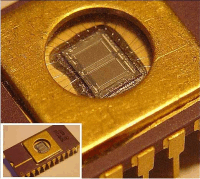 UV Erasable Programmable ROM
UV Erasable Programmable ROM (UV EPROM). Both the manufacturing process and characteristics of this memory are completely identical to OTP ROM. However, the package of this microcontroller has a recognizable “window” on the upper side. It enables the surface of the silicon chip inside to be lit by an UV lamp, which effectively erases and program from the ROM.
Installation of this window is very complicated, which normally affects the price. From our point of view, unfortunately- negative...
Flash memory. This type of memory was invented in the 80s in the laboratories of INTEL and were represented as the successor to the UV EPROM. Since the contents of this memory can be written and cleared practically an unlimited number of times, the microcontrollers with Flash ROM are ideal for learning, experimentation and small-scale manufacture. Because of its popularity, the most microcontrollers are manufactured in flash versions today. So, if you are going to buy a microcontroller, the type to look for is definitely Flash!
Random Access Memory (RAM)
Once the power supply is off the contents of RAM (Random Access Memory) is cleared. It is used for temporary storing data and intermediate results created and used during the operation of the microcontroller. For example, if the program performs an addition (of whatever), it is necessary to have a register representing what in everyday life is called the “sum”. For that purpose, one of the registers in RAM is called the “sum” and used for storing results of addition.
Electrically Erasable Programmable ROM (EEPROM)
The contents of the EEPROM may be changed during operation (similar to RAM), but remains permanently saved even upon the power supply goes off (similar to ROM). Accordingly, an EEPROM is often used to store values, created during operation, which must be permanently saved. For example, if you design an electronic lock or an alarm, it would be great to enable the user to create and enter a password, but useless if it is lost every time the power supply goes off. The ideal solution is the microcontroller with an embedded EEPROM.
Interrupt
The most programs use interrupts in regular program execution. The purpose of the microcontroller is mainly to react on changes in its surrounding. In other words, when some event takes place, the microcontroller does something... For example, when you push a button on a remote controller, the microcontroller will register it and respond to the order by changing a channel, turn the volume up or down etc. If the microcontroller spent most of its time endlessly a few buttons for hours or days... It would not be practical.
The microcontroller has learnt during its evolution a trick. Instead of checking each pin or bit constantly, the microcontroller delegates the “wait issue” to the “specialist” which will react only when something attention worthy happens.
The signal which informs the central processor about such an event is called an INTERRUPT.
Central Processor Unit (CPU)
As its name suggests, this is a unit which monitors and controls all processes inside the microcontroller. It consists of several smaller subunits, of which the most important are:
- Instruction Decoder is a part of the electronics which recognizes program instructions and runs other circuits on the basis of that. The “instruction set” which is different for each microcontroller family expresses the abilities of this circuit.
- Arithmetical Logical Unit (ALU) performs all mathematical and logical operations upon data.
- Accumulator is a SFR closely related to the operation of the ALU. It is a kind of working desk used for storing all data upon which some operation should be performed (addition, shift/move etc.). It also stores the results ready for use in further processing. One of the SFRs, called a Status Register (PSW), is closely related to the accumulator. It shows at any given moment the “status” of a number stored in the accumulator (number is greater or less than zero etc.).
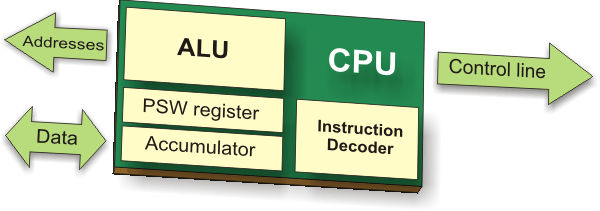
Fig. 0-22 Central Processor Unit - CPU
Bus
Physically, the bus consists of 8, 16 or more wires. There are two types of buses: the address bus and the data bus. The address bus consists of as many lines as necessary for memory addressing. It is used to transmit the address from the CPU to the memory. The data bus is as wide as the data, in our case it is 8 bits or wires wide. It is used to connect all circuits inside the microcontroller.
Serial Communication
Parallel connections between the microcontroller and peripherals via input/output ports is the ideal solution for shorter distances- up to several meters. However, in other cases - when it is necessary to establish communication between two devices on longer distances it is not possible to use a parallel connection - such a simple solution is out of question. In these situations, serial communication is the best solution.
Today, most microcontrollers have built in several different systems for serial communication as a standard equipment. Which of these systems will be used depends on many factors of which the most important are:
- How many devices the microcontroller has to exchange data with?
- How fast the data exchange has to be?
- What is the distance between devices?
- Is it necessary to send and receive data simultaneously?
One of the most important things concerning serial communication is the
Protocol which
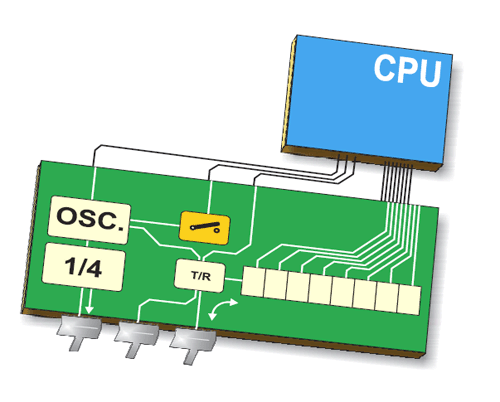
Fig. 0-23 Serial communication
should be strictly observed. It is a set of rules which must be applied in order that the devices can correctly interpret data they mutually exchange. Fortunately, the microcontrollers automatically take care of this, so the work of the programmer/user is reduced to simple write (data to be sent) and read (received data).
Baud Rate
The term
Baud rate is commonly used to denote the number of bits transferred per second [bps].
It should be noted that it refers to bits, not bytes! It is usually required by the protocol that each byte is transferred along with several control bits. It means that one byte in serial data stream may consist of 11 bits. For example, if the baud rate is 300 bps then maximum 37 and minimum 27 bytes may be transferred per second, which depends on type of connection and protocol in use.
The most commonly used serial communication systems are:
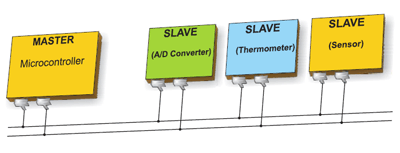 I2C
I2C (Inter Integrated Circuit) is a system used when the distance between the microcontrollers is short and specialized integrated circuits of of a new generation (receiver and transmitter are usually on the same printed circuit board). Connection is established via two conductors- one is used for data transfer whereas another is used for synchronization (clock signal). As seen in figure, one device is always the master. It performs addressing of one slave chip (subordinated) before communication starts. In this way one microcontroller can communicate with 112 different devices. Baud rate is usually 100 Kb/sec (standard mode) or 10 Kb/sec (slow baud rate mode). Systems with the baud rate of 3.4 Mb/sec have recently appeared. The distance between devices which communicate via an inter-integrated circuit bus is limited to several meters.
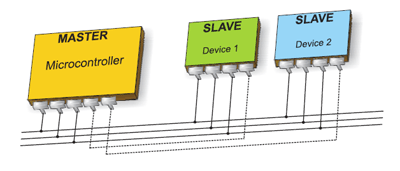 SPI
SPI (Serial Peripheral Interface Bus) is a system for serial communication which uses up to four conductors (usually three)- one for data receiving, one for data sending, one for synchronization and one (alternatively) for selecting the device to communicate with. It is full duplex connection, which means that data is sent and received simultaneously. The maximum baud rate is higher than in I2C connection.
UART (Universal Asynchronous Receiver/Transmitter)
This connection is asynchronous, which means that a special line for clock signal transmission is not used. In some situations this feature is crucial (for example, radio connection or infrared waves remote control). Since only one communication line is used, both receiver and transmitter operate at the same predefined rate in order to maintain necessary synchronization. This is a very simple way of transferring data since it basically represents conversion of 8-bit data from parallel to serial format. Baud rate is not high up to 1 Mbit/sec.
Oscillator
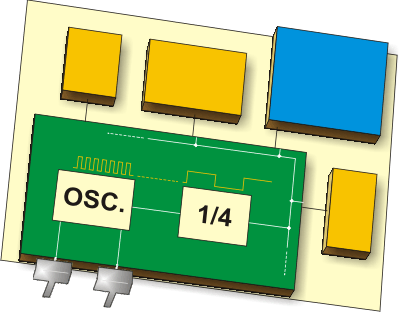
Even pulses coming from the oscillator enable harmonic and synchronous operation of all circuits of the microcontroller. The oscillator module is usually configured to use quartz crystal or ceramic resonator for frequency stabilization. Furthermore, it can also operate without elements for frequency stabilization (like RC oscillator). It is important to say that instructions are not executed at the rate imposed by the oscillator itself, but several times slower. It happens because each instruction is executed in several steps. In some microcontrollers, the same number of cycles is needed to execute any instruction, while in others, the execution time is not the same for all instructions. Accordingly, if the system uses quartz crystal with a frequency of 20 Mhz, execution time of an instruction is not 50nS, but 200, 400 or 800 nS, depending on the type of Microcontroller Unit (MCU)!
Power supply circuit
There are two things worth attention concerning the microcontroller power supply circuit:
Brown-out is a potentially dangerous state which occurs at the moment the microcontroller is being turned off or in situations when power supply voltage drops to the limit due to electric noise. As the microcontroller consists of several circuits which have different operating voltage levels, this state can cause its out-of-control performance. In order to prevent it, the microcontroller usually has built-in circuit for brown out reset. This circuit immediately resets the whole electronics when the voltage level drops below the limit.
Reset pin is usually marked as MCLR (Master Clear Reset) and serves for external reset of the microcontroller by applying logic zero (0) or one (1), depending on type of the microcontroller. In case the brown out circuit is not built in, a simple external circuit for brown out reset can be connected to this pin.
Timers/Counters
The microcontroller oscillator uses quartz crystal for its operation. Even though it is not the simplest solution, there are many reasons to use it. Namely, the frequency of such oscillator is precisely defined and very stable, the pulses it generates are always of the
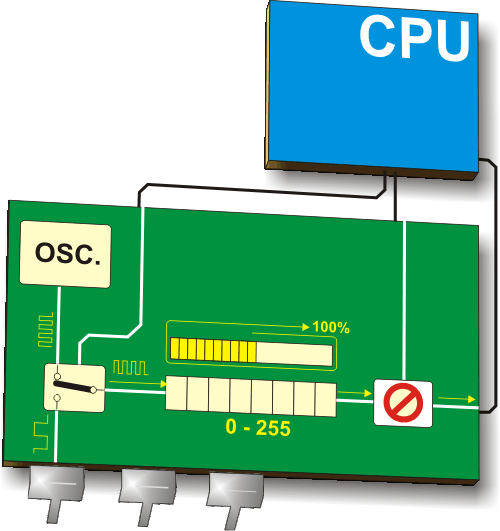
Fig. 0-27 Timers/Counters
same width, which makes them ideal for time measurement. Such oscillators are used in quartz watches. If it is necessary to measure time between two events, it is sufficient to count pulses coming from this oscillator. That is exactly what the timer does.
Most programs use these miniature electronic “stopwatches”. These are commonly 8- or 16-bit SFRs and their content is automatically incremented by each coming pulse. Once a register is completely loaded - an interrupt is generated!
If the timer registers use an internal quartz oscillator for their operation then it is possible to measure time between two events (if the register value is T1 at the moment measurement has started, and T2 at the moment it has finished, then the elapsed time is equal to the result of subtraction T2-T1). If the registers use pulses coming from external source then such a timer is turned into a counter.
This is only a simple explanation of the operation itself.
How does a timer operate?
In practice pulses coming from the quartz oscillator are once per each machine cycle directly or via a prescaler brought to the circuit which increments the number in the timer register. If one instruction (one machine cycle) lasts for four quartz oscillator periods then, by embedding quartz with the frequency of 4MHz, this number will be changed a million times per second (each microsecond).
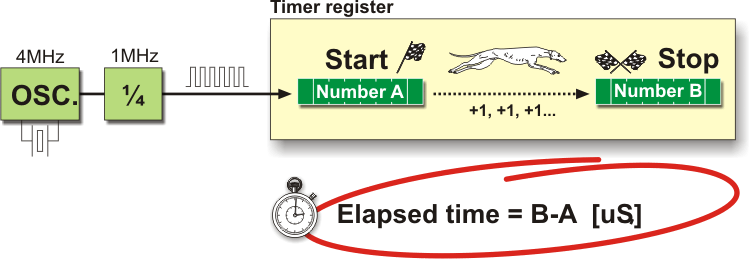
Fig. 0-28 Timer Operation
It is easy to measure short time intervals (up to 256 microseconds) in the way described above because it is the largest number that one register can contain. This obvious disadvantage may be easily overcome in several ways by using a slower oscillator, registers with more bits, a prescaler or interrupts. The first two solutions have some weaknesses so it is preferable to use prescalers or interupts.
Using prescaler in timer operating
A prescaler is an electronic device used to reduce a frequency by a pre-determined factor. Meaning that in order to generate one pulse on its output, it is necessary to bring 1, 2 , 4 or more pulses to its input. One such circuit is built in the microcontroller and its division rate can be changed from within the program. It is used when it is necessary to measure longer periods of time.
One prescaler is usually shared by timer and watch-dog timer, which means that it cannot be used by both of them simultaneously.
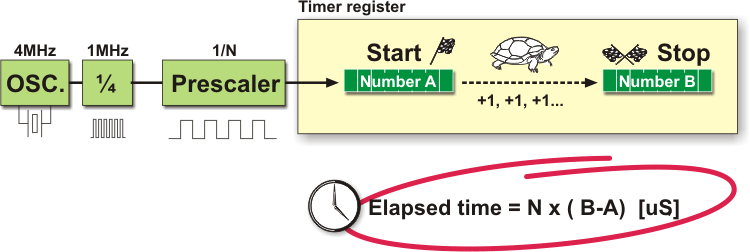
Fig. 0-29 Using prescaler in timer operating
Using the interrupt in timer operation
If the timer register consists of 8 bits, the largest number that can be written to it is 255 (for 16-bit registers it is the number 65.535). If this number is exceeded, the timer will be automatically reset and counting will start from zero again. This condition is called overflow. If enabled from within the program, such overflow can cause an interrupt, which gives completely new possibilities. For example, the state of registers used for counting seconds, minutes or days can be changed in an interrupt routine. The whole process (except interrupt routine) is automatically performed “in the background”, which enables the main circuits of the microcontroller to perform other operations.
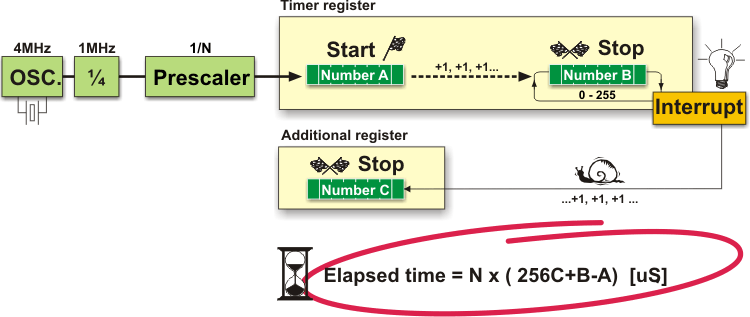
Fig. 0-30 Using the interrupt in timer operation
This figure illustrates the use of the interrupt in timer operation. Delays of arbitrary duration with minimal interference by the main program execution can be easily obtained by assigning a prescaler to the timer.
Counters
If a timer is supplying pulses into the microcontroller input pin then it turns into a counter. Clearly, It is the same electronic circuit. The only difference is that in this case pulses to be counted come through the ports and their duration (width) is mostly not defined. This is why they cannot be used for time measurement, but can be used to measure anything else: products on an assembly line, number of axis rotation, passengers etc. (depending on sensor in use).
Watchdog Timer
The Watchdog Timer is a timer connected to a completely separate RC oscillator within the microcontroller.
If the watchdog timer is enabled, every time it counts up to the program end, the microcontroller reset occurs and program execution starts from the first instruction. The point is to prevent this from happening by using a specific command. The whole idea is based on the fact that every program is executed in several longer or shorter loops.
If instructions which reset the watchdog timer are set at the appropriate program locations, besides commands being regularly executed, then the operation of the watchdog timer will not affect program execution. If for any reason (usually electrical noises in industry), the program counter “gets stuck” on some memory location from which there is no return, the watchdog will not be cleared and the register’s value being constantly incremented will reach the maximum et voila! Reset occurs!
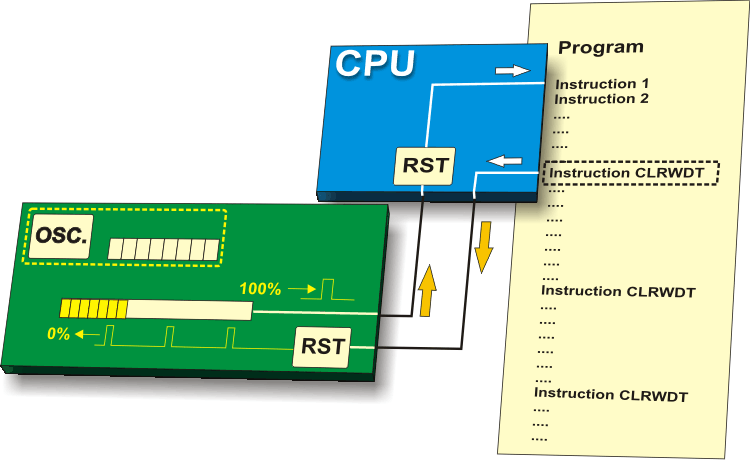
Fig. 0-31 Watchdog Timer
A/D Converter
External signals are usually fundamentally different from those the microcontroller understands (Ones and Zeros), so that they have to be converted in order for the microcontroller to understand them. An analogue to digital converter is an electronic circuit which converts continuous signals to discrete digital numbers. This module is therefore used to convert some analogue value into binary number and forwards it to the CPU for further processing. In other words, this module is used for input pin voltage measurement (analogue value). The result of measurement is a number (digital value) used and processed later in the program.
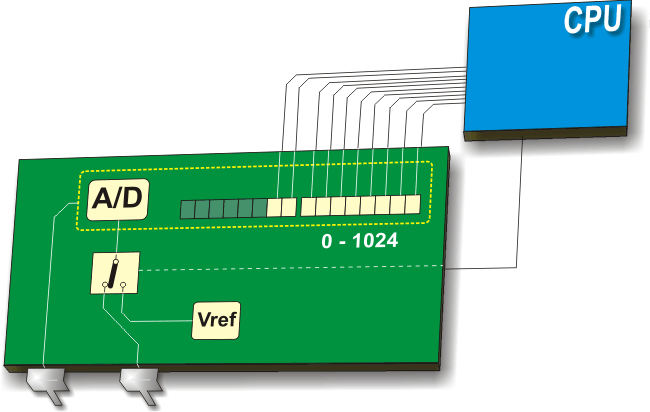
Fig. 0-32 A/D Converter
Internal Architecture
All upgraded microcontrollers use one of two basic design models called Harvard and von-Neumann architecture.
Briefly, they are two different ways of data exchange between CPU and memory.
von-Neumann Architecture
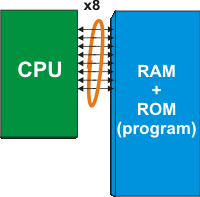
Microcontrollers using this architecture have only one memory block and one 8-bit data bus. As all data are exchanged by using these 8 lines, this bus is overloaded and communication itself is very slow and inefficient. The CPU can either read an instruction or read/write data from/to the memory. Both cannot occur at the same time since the instructions and data use the same bus system. For example, if some program line says that RAM memory register called “SUM” should be incremented by one (instruction: incf SUM), the microcontroller will do the following:
- Read the part of the program instruction specifying WHAT should be done (in this very case it is the “incf” instruction for increment).
- Read further the same instruction specifying upon WHICH data it should be performed (in this very case it is the “SUM” register).
- After being incremented, the contents of this register should be written to the register from which it was read (“SUM” register address).
The same data bus is used for all these intermediate operations.
Harvard Architecture
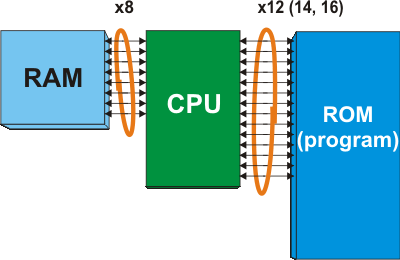
Microcontrollers using this architecture have two different data buses. One is 8 bits wide and connects CPU to RAM. Another consists of several lines (12, 14 or 16) and connects CPU to ROM. Accordingly, the CPU can read an instruction and perform a data memory access at the same time. Since all RAM memory registers are 8 bits wide, all data within the microcontroller are exchanged in the same such format. Additionally, during program writing, only 8 bits data are considered. In other words, all you can ever change from within the program and all you can affect will be 8 bits wide. A program written for some of these microcontrollers will be stored in the microcontroller internal ROM upon having being compiled into machine language. However, these memory locations do not have 8, but 12, 14 or 16 bits. The rest of bits- 4, 6 or 8- represents the instruction itself specifying to the CPU what to do with the 8-bit data.
The advantages of such design are the following:
- All data in a program is one byte (8 bit) wide. As the data bus used for program reading has several lines (12, 14 or 16), both instructions and data can be read simultaneously by using these spare bits. Therefore, all instructions are executed in only one instruction cycle. The only exception is jump instruction which is executed in two cycles.
- Owing to the fact that a program (ROM) and temporary data (RAM) are separate, the CPU can execute two instructions simultaneously. Simply, while RAM read or write is in progress (the end of one instruction), the next program instruction is being read via another bus.
- When using microcontrollers with von-Neumann architecture one never knows how much memory is to be occupied by some program. Basically, each program instruction occupies two memory locations (one contains information on WHAT should be done, whereas another contains information upon WHICH data it should be done). However, it is not a hard and fast rule, but the most common case. In microcontrollers with Harvard architecture, the program bus is wider than one byte, which allows each program word to consist of instruction and data. In other words: one program word- one instruction.
INSTRUCTION SET
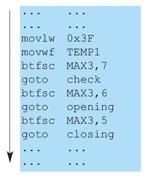
Instructions that can be understood by the microcontroller are known as an instruction set. When you write a program in assembly language, you actually “tell a story” by specifying instructions in the order they should be executed. The main restriction in this process is the number of available instructions. The manufacturers stick to one of the two following strategies:
RISC (Reduced Instruction Set Computer)
In this case, the microcontroller recognizes and executes only basic operations (addition, subtraction, copying etc.). All other more complicated operations are performed by combining these (for example, multiplication is performed by performing successive addition). The constrains are obvious (try by using only a few words, to explain to someone how to reach the airport in some other city). However, there are also some great advantages. First of all, this language is easy to learn. Besides, the microcontroller is very fast so that it is not possible to see all the arithmetic “acrobatics” it performs. The user can only see the final result of all those operations. At last, it is not so difficult to explain where the airport is if you use the right words. For example: left, right, kilometers etc.
CISC (Complex Instruction Set Computer)
CISC is the opposite of RISC! Microcontrollers designed to recognize more than 200 different instructions can do much and are very fast. However, one needs to understand how to take all that such a rich language offers, which is not at all easy...
How to make the right choice
Ok, you are the beginner and you have made a decision to go on an adventure of working with the microcontrollers. Congratulations on your choice! However, it is not as easy to choose the right microcontroller as it may seem. The problem is not a limited range of devices, but the opposite!
Before you start designing some device based on the microcontroller, think of the following: how many input/output lines will I need for operation? Should it perform some other operations than to simply turn relays on/off? Does it need some specialized module such as serial communication, A/D converter etc. When you create a clear picture of what you need, the selection range is considerably reduced, then it is time to think of price. Is your plan to have several same devices? Several hundred? A million? Anyway, you get the point...
If you think of all these things for the very first time then everything seems a bit confusing. For that reason, go step by step. First of all, select the manufacturer, i.e. the family of the microcontrollers you can easily obtain. After that, study one particular model. Learn as much as you need, do not go into details. Solve a specific problem and something incredible will happen- you will be able to handle any model belonging to that family.
Remember learning to ride a bicycle: after several unavoidable bruises at the beginning, you will manage to keep balance and will be able to easily ride any other bicycle. And of course, you will never forget the skill in programming just as you will never forget riding bicycles!
PIC microcontrollers
PIC microcontrollers designed by Microchip Technology are likely the right choice for you if you are the beginner. Here is why...
The real name of this microcontroller is PICmicro (Peripheral Interface Controller), but it is better known as PIC. Its first ancestor was designed in 1975 by General Instruments. This chip called PIC1650 was meant for totally different purposes. About ten years later, by adding EEPROM memory, this circuit was transformed into a real PIC microcontroller. Nowadays, Microchip Technology announces a manufacturing of the 5 billionth sample...
In order that you can better understand the reasons for its popularity, we will briefly describe several important things.
| Family | ROM [Kbytes] | RAM [bytes] | Pins | Clock Freq. [MHz] | A/D Inputs | Resolution of A/D Converter | Compar- ators | 8/16 – bit Timers | Serial Comm. | PWM Outputs | Others |
| Base-Line 8 - bit architecture, 12-bit Instruction Word Length |
| PIC10FXXX | 0.375 - 0.75 | 16 - 24 | 6 - 8 | 4 - 8 | 0 - 2 | 8 | 0 - 1 | 1 x 8 | - | - | - |
| PIC12FXXX | 0.75 - 1.5 | 25 - 38 | 8 | 4 - 8 | 0 - 3 | 8 | 0 - 1 | 1 x 8 | - | - | EEPROM |
| PIC16FXXX | 0.75 - 3 | 25 - 134 | 14 - 44 | 20 | 0 - 3 | 8 | 0 - 2 | 1 x 8 | - | - | EEPROM |
| PIC16HVXXX | 1.5 | 25 | 18 - 20 | 20 | - | - | - | 1 x 8 | - | - | Vdd = 15V |
| Mid-Range 8 - bit architecture, 14-bit Instruction World Length |
| PIC12FXXX | 1.75 - 3.5 | 64 - 128 | 8 | 20 | 0 - 4 | 10 | 1 | 1 - 2 x 8 1 x 16 | - | 0 - 1 | EEPROM |
| PIC12HVXXX | 1.75 | 64 | 8 | 20 | 0 - 4 | 10 | 1 | 1 - 2 x 8 1 x 16 | - | 0 - 1 | - |
| PIC16FXXX | 1.75 - 14 | 64 - 368 | 14 - 64 | 20 | 0 - 13 | 8 or 10 | 0 - 2 | 1 - 2 x 8 1 x 16 | USART I2C SPI | 0 - 3 | - |
| PIC16HVXXX | 1.75 - 3.5 | 64 - 128 | 14 - 20 | 20 | 0 - 12 | 10 | 2 | 2 x 8 1 x 16 | USART I2C SPI | - | - |
| High-End 8 - bit architecture, 16-bit Instruction Word Length |
| PIC18FXXX | 4 - 128 | 256 - 3936 | 18 - 80 | 32 - 48 | 4 - 16 | 10 or 12 | 0 - 3 | 0 - 2 x 8 2 - 3 x 16 | USB2.0 CAN2.0 USART I2C SPI | 0 - 5 | - |
| PIC18FXXJXX | 8 - 128 | 1024 - 3936 | 28 - 100 | 40 - 48 | 10 - 16 | 10 | 2 | 0 - 2 x 8 2 - 3 x 16 | USB2.0 USART Ethernet I2C SPI | 2 - 5 | - |
| PIC18FXXKXX | 8 - 64 | 768 - 3936 | 28 - 44 | 64 | 10 - 13 | 10 | 2 | 1 x 8 3 x 16 | USART I2C SPI | 2 | - |
 (Personal Computers, workstations, mainframes and servers) but
surprisingly, billions of computing systems are built every year
embedded within larger electronic devices and still goes unnoticed. Any
device running on electric power either already has computing system or
will soon have computing system embedded in it.
(Personal Computers, workstations, mainframes and servers) but
surprisingly, billions of computing systems are built every year
embedded within larger electronic devices and still goes unnoticed. Any
device running on electric power either already has computing system or
will soon have computing system embedded in it.  (Personal Computers, workstations, mainframes and servers) but
surprisingly, billions of computing systems are built every year
embedded within larger electronic devices and still goes unnoticed. Any
device running on electric power either already has computing system or
will soon have computing system embedded in it.
(Personal Computers, workstations, mainframes and servers) but
surprisingly, billions of computing systems are built every year
embedded within larger electronic devices and still goes unnoticed. Any
device running on electric power either already has computing system or
will soon have computing system embedded in it. 






































